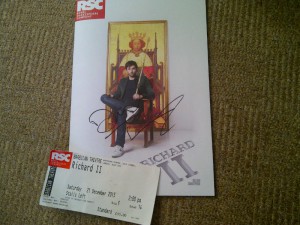On December 21st, 2013, I was lucky enough to see the RSC’s production of Richard II at the Barbican. Seeing such a prestigious production of one of William Shakespeare’s great History plays was a truly fantastic experience!
The Royal Shakespeare Company (RSC) is probably one of the most internationally famous theatre companies, having an extensive repertoire of celebrated and iconic creative works throughout it’s over 50 year history. I have seen productions performed by the RSC previous to Richard II, having seen Romeo and Juliet at the Swan Theatre in Stratford-upon-Avon in 2009. However, seeing an RSC production in London on an end-on stage, as opposed to the thrust stages of the Swan and Royal Shakespeare Theatres in Stratford, was an interesting and enjoyable experience.
David Tennant, starring as the eponymous role of King Richard II, was captivating and enigmatic in his effeminate, eccentric, divine and immaturely petulant take on the once child king. He was a king who affirmed his divine right to rule not by balanced wisdom or even majestic strength, but through lavish imagery. Tennant’s costumes transformed him into a living jewel, as though he were some earthbound angel, confirming his majesty and power through symbolism as opposed to tangible action. Tennant was a Richard who existed with his head arrogantly located amongst the clouds, being distant and cold to his most important advisers, allies, and family, instead preferring to indulge in the flattery of Bushy, Bagot and Green; one had the distinct sense here of a spoilt child being pandered to by indulgent parents. Yet, when Richard’s world comes crashing down around him as rebellion ignites, led by his cousin, Henry Bolingbroke, Tennant transformed the proud king into a crumpled little boy, clawing at the soil to which he is sovereign. Tennant’s was a Richard who was flamboyant and arrogant, proud and petulant, and, above all, fascinating to watch.
However, despite generally impressive performances from most of the cast, though I admittedly felt uninspired by Nigel Lindsay’s blandly rock-steady Bolingbroke, it was the production’s set and use of live music that truly fascinated and inspired me. The production was interlaced by use of musical compositions of brass and choral music, with three brass musicians set on a balcony stage right, and three female singers set on a balcony stage left; directly opposite the brass musicians. Such music, with the brass producing frequent fanfares, and the three girls singing ecclesiastical, choral arrangements, created a sense of medieval regality while also incorporating the medieval ideas of monarchy’s connection with the divine, as well as hinting towards the real Richard’s promotion and appreciation of the arts. Such effectively beautiful and atmospheric music informed my arts practice in the sense that live music can be incorporated into live performances in such a way that enhances the drama rather than distracting from it. Depending on one’s intentions as a director as to the desired impact of the music, seeing this use of live performed music allowed me to consider the collaboration between actors, directors and musicians in order to create a single, affecting and successful production.
The set for this production of Richard II was also particularly fascinating to me. Rather than conventional painted sets or physical set pieces, this production used projected images, projected onto what appeared to be curtain-wings of fine chains. This very effectively created realistic settings that were yet made three dimensional by the unusual chain curtains; for example, the court scenes had projections of a vaulted stone building, with the staggered curtains giving the effect of depth to the projection, while the fan-vaulting and Gothic pillars of the building setting were clearly visible. It was a real marvel to see, as the set did not distract from the action, and yet added a historical, ghost-like quality to the performance, perhaps hinting to the issue of Bolingbroke being haunted by Richard’s murder at the end of the play (a haunting guilt which manifests itself in Shakespeare’s Henry IV parts 1 and 2). This style of set informed my arts practice by opening my mind to new and innovative ways of creating sets within theatre spaces. With new developments in the use of projection, such as projection mapping (as seen on Buckingham Palace during the Queen’s Diamond Jubilee celebrations), seeing such artistry in use has allowed me to consider further how sets can be created for a theatre production, and what artistic impact this has upon the intentions of the play. Indeed, modern technology is not at all out of place in the space of a theatre, and can indeed create wonderful, fascinating and moving creative pieces within such a space, as the set of Richard II proved.
